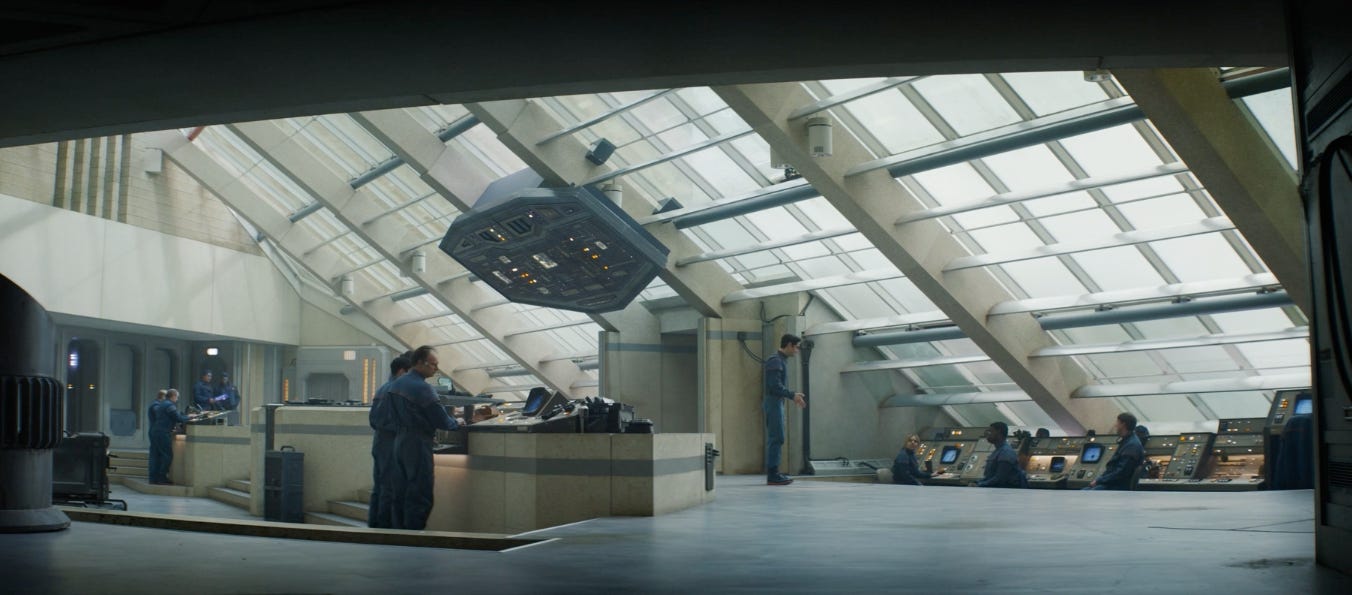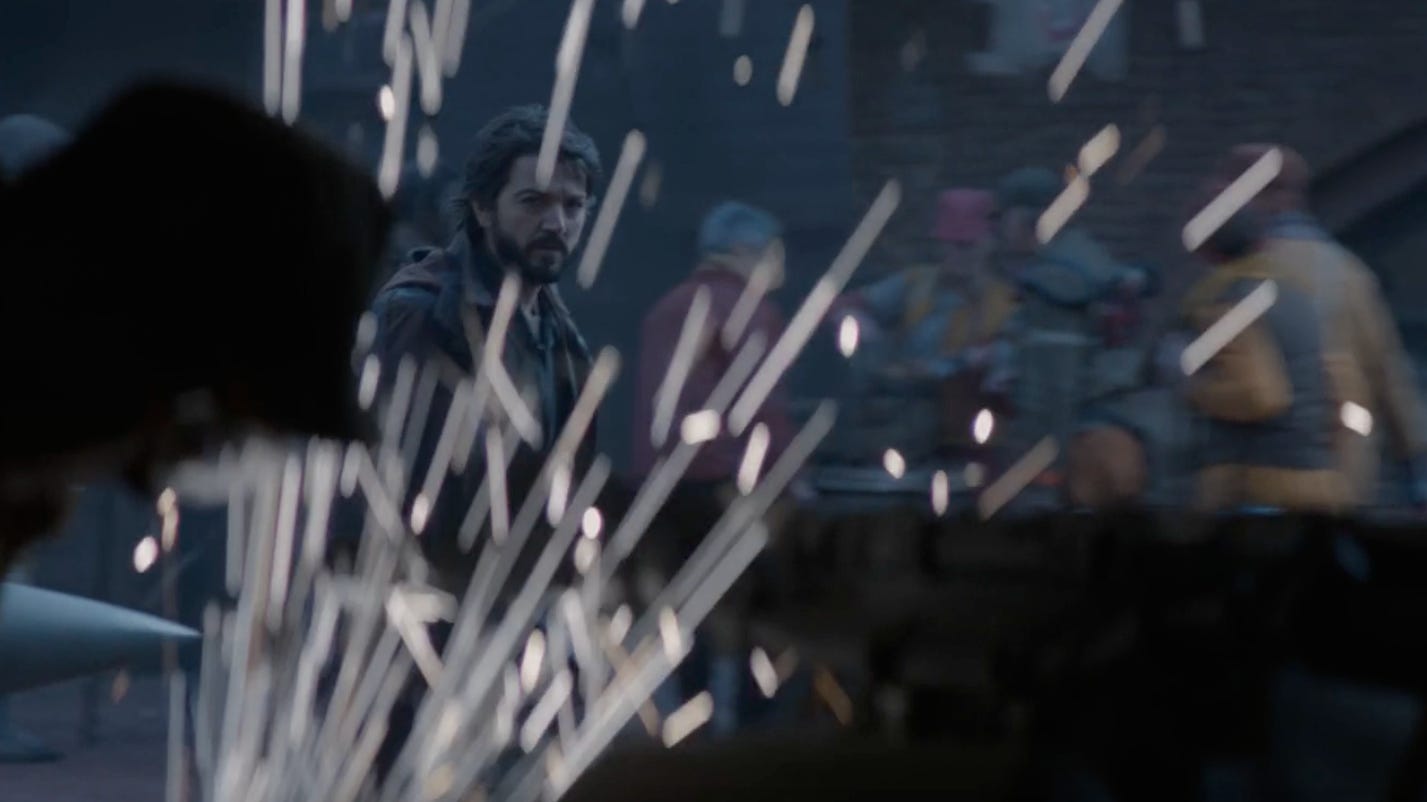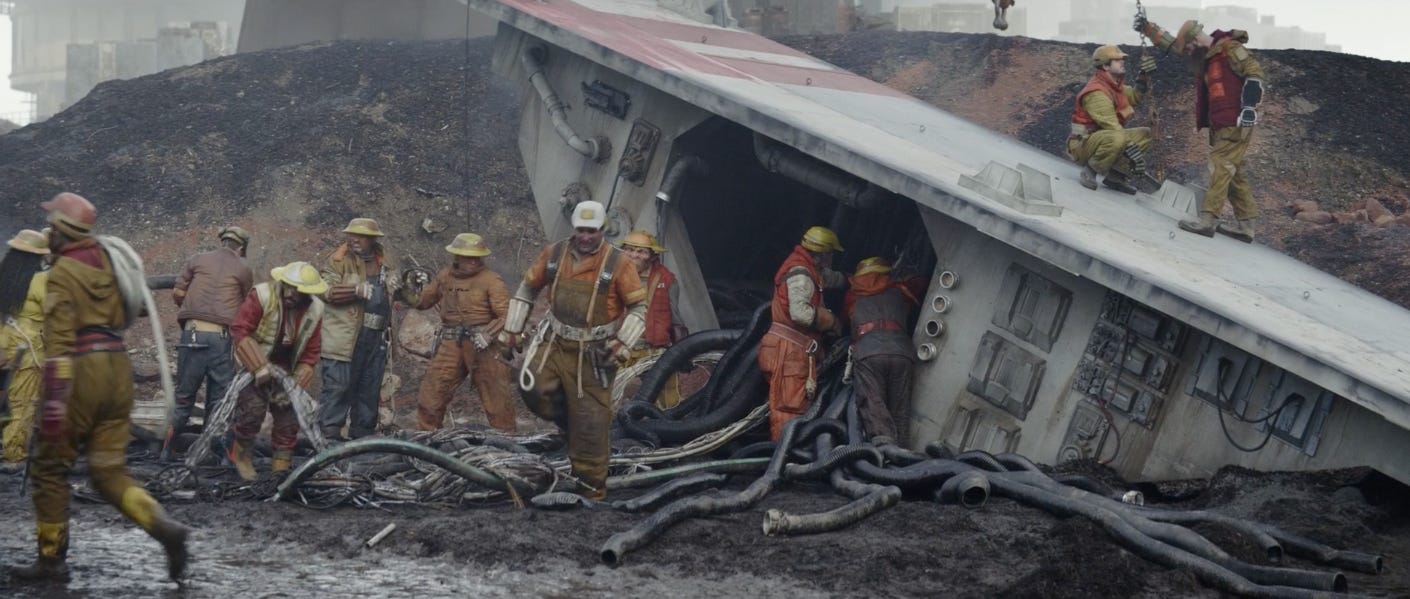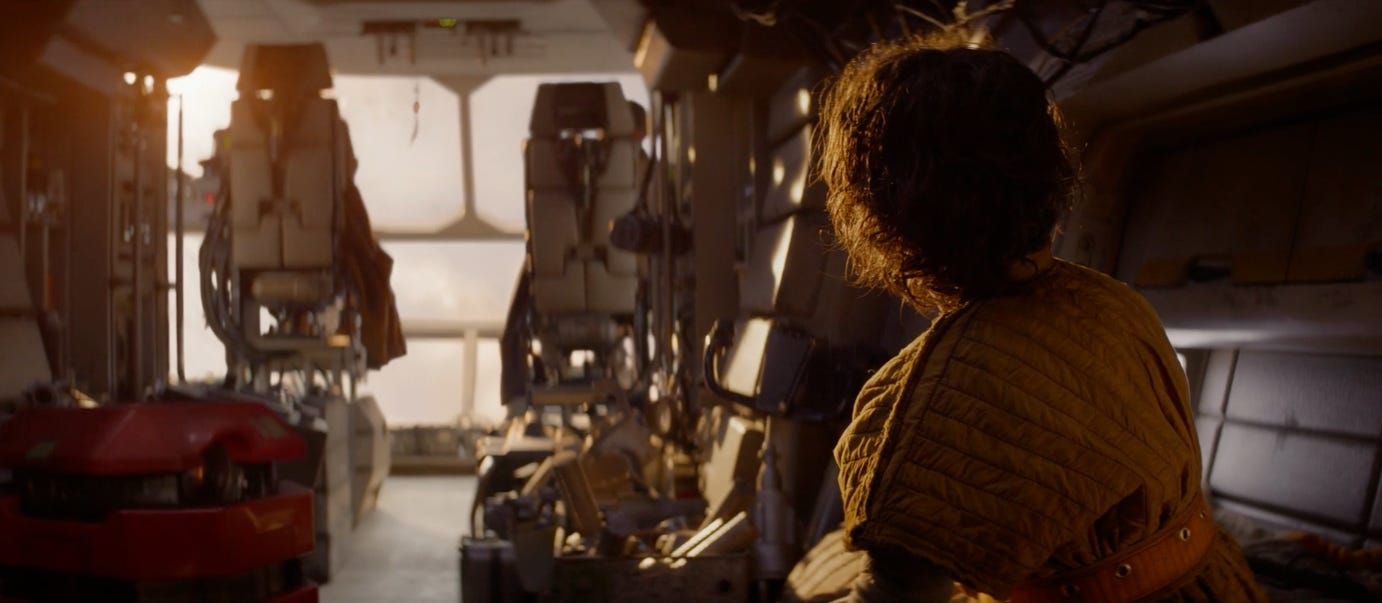Let’s talk about 16 hidden messages in Andor’s first three episodes.
Andor is the first high-quality Star Wars project ever with recurring motifs and themes we can spot and analyze. I blame veteran head writer Tony Gilroy for giving us such a quality show.
Without further ado, let’s get into the hidden messages of episodes 1-3 one by one.
Episode 1 - Kassa
Let’s begin with episode 1. To watch the video version of this breakdown, click here.
Fire
When Cassian’s a boy on Kenari, he lives amongst a tribe of other children. Before they go out on a hunting mission, they smear themselves with ashes from their fire.
Fire is important to this show, I think.
Ferrix is a highly industrialized planet featuring houses made of bricks. To make bricks, you need to mix, mold, and burn them in a furnace, right?
And later we find out that the dead on Ferrix become bricks themselves. They get cremated, and their ashes are then mixed with mortar, turning them into bricks.
We have to look at the clothing of people on Ferrix as well. They wear a mix of red, orange, and yellow colors predominantly. Cassian himself wears a dark red jacket, and his droid is dark red as well.
And what color are bricks? I don’t need to answer that one.
What about the wall of gloves? There’s a mix of yellow, red, and orange present here.
It’s fitting. The people of Ferrix represent the ember of early rebellion that eventually catches fire across the galaxy.
What better metaphor than fire to showcase the feelings of the rebels?
Which brings me to my next point.
Corporate vs. Blue Collar
The first scene takes place on Morlana 1, in the Preox-Morlana corporate zone. Preox-Morlana is a corporate entity the Empire hired to act as a governing body in the sector Ferrix exists in.
Contrasting Morlana to Ferrix is fascinating.
Preox-Morlana is a corporate entity. Ferrix is a planet of blue collar workers.
Morlana’s offices have a ton of white light that shines through windows built above them. Ferrix is more colorful with its reds, oranges, and yellows, and it’s also darker. There’s not a lot of light that gets in through their dense brick buildings.
You could see this difference in transparency in two ways.
One, Morlana can see all. In one scene, Syril Karn checks flight logs with a co-worker. They stare at a transparent screen and pinpoint the ship Cassian took to visit Morlana 1. His ship is shown in yellow, by the way.
They’re able to see everything.
The second way we could interpret the windows vs. bricks design difference is through the lens of fragility. The empire is fragile in this series. And they’re fragile because they’re lazy, cocky, and arrogant. That arrogance creates ignorance, which is something the rebels exploit to their advantage.
If you threw a brick at a glass window, it would shatter. If you threw a brick at a brick, it’d bounce off it like a bullet off the Incredible Hulk.
And Episode 1 of Andor makes it a point to show how lazy these corporate workers actually are. The only one who’s actually doing anything is Syril Karn, which is annoying for the audience since we want Andor to get away with everything.
The people of Ferrix, though, are hard-workers. Tough. Resilient. Strong. Like bricks.
They represent a way of life—a set of values—that’s stronger and more durable than the cockiness of the Empire. If you listen closely to the music on Ferrix, you can hear sounds of tools clanking and banging together as the heart and soul of the beat.
Not to mention the colors of Morlana corporate uniforms are BLUE. A color diametrically opposed to the reds of people on Ferrix. You could interpret blue as a cold, rigid color, which is exactly how the Empire is. Cold and rigid.
One guy on Morlana 1 is even eating blue noodles, and the ship log that Syril Karn looks at with his associate is blue, too.
The Color White
Let’s continue on this caravan of color.
The first shot of Andor is a dolly of bright white lights passing by as Andor walks across a dock. He hides his face from them with a hood.
In Morlana corporate offices, a lot of WHITE LIGHT cascades through the windows above.
The empire in Star Wars represents white, of course. A color that we’ll see more of in the infamous jail Andor gets trapped in and the meeting room where Empire leaders meet.
They rule with an iron fist. They have very strict rules on what is and isn’t allowed. There’s no freedom or nuance with them. Only rules. Black and white.
These color design choices create a very interesting dichotomy between the cold, rigid nature of the empire and the fiery, passionate nature of the rebels.
The Hounds
My favorite scene of this episode is when the Corellian hounds come running into the street and pee on B2EMO. Then B2 shocks them. By the way electricity—that’s something that’ll show up later in the show.
Believe that.
Anyway, I think the hounds are a representation of the Empire. They’re figuratively taking a piss on the entire galaxy, and too stupid to see that the people they’re pissing on are more than capable of defending themselves.
Why put this scene in the episode? Comic relief?
I don’t think so. I think it was meant to show something more.
Lying
In the very next scene, Cassian asks B2EMO to make a lie. He says that he knows it takes a lot of energy to do so.
There’s actually a lot of lying in this episode on all sides.
Cassian visits Brasso and they create a story together about how they went out and got drunk the night before. Chief Hyne makes up a lie about how the two officers that Cassian killed actually died in an accident.
Cassian isn’t entirely truthful with Bix about parts he has to sell, and doesn’t tell the hanger dude where he took his ship.
Lying is important in Andor. There’s a lot more where that came from throughout this series, obviously.
But I do want to zero in on the point that lying takes a lot of energy for droids. It takes a lot of energy for humans, too. It’s almost like you have to work twice as hard at all times, since you’re doing the thing you’re lying about and making up a suitable story that covers up the lie.
This fact raises the stakes of the show a good deal higher, making it so much harder for our protagonists. And like I said before, Ferrix is a dark planet with lots of alleyways, corridors, and buildings with little to no windows for light to pierce through.
I think this reinforces the idea that Bix, Brasso, Cassian, and more people on Ferrix are straining themselves to cover a lot of stuff up.
Height
Andor Episode 1 features a lot of conversations where one person is “higher” than another. Syril Karn is a perfect example. In his first meeting with Chief Hyne, he’s visually higher than him most of the time, representing his deeper commitment to the cause than his own Chief, who doesn’t care that two of his men were just killed.
Syril interacts twice more with “grunt” workers that are framed below him. Once when finding Cassian’s ship on the ship logs, and another when he tries to motivate a few workers to find more information about Cassian’s whereabouts.
His feet are literally where their heads are in this scene.
When Cassian fights the two Pre-Mor employees, he relishes the power he has over them by shouting “Tell me now! Tell me what to do!”
He stands over them.
Even when he asks Brasso to lie for him, Brasso stands over him, almost in an intimidating fashion, as they make up a lie together.
Later somebody tries to get Cassian to give him his money, using a big friend of Cassian’s as added intimidation.
Finally, what about the ending scene where Cassian talks down to the shipyard groundskeeper from height?
Not only are there a lot of visual power dynamics, but spoken ones.
Chief Hyne laments about one of the murdered Pre-Mor employees who fell a long way in the chain of command.
Chief Hyne himself needs to go report to the Empire.
And he even tells Syril to not put his feet up on the desk while he’s gone.
Not to mention the fact that Cassian wants to get into contact with Bix’s buyer immediately—someone who’s literally at the top of the rebel chain of command.
And what does Bix have to do to contact this mysterious figure?
She must climb a ladder and hack into a communication relay to send a message to him.
Then we have the scene of Cassian as a boy, who wants to be part of the scouting party, but initially gets turned down by a boy sitting next to him.
Andor will continue to play with height and climbing and power dynamics throughout the show, so stay tuned on that.
Episode 2 - That Would Be Me
Let’s break down Episode 2. If you want the video version of this breakdown, click here.
Sparks
At the start of the episode, Andor takes a stroll down main street and is framed behind a bunch of sparks from somebody cutting something.
The last shot of the episode shows the same thing. Andor walking down the street as someone cuts a piece of metal, sparks flying everywhere.
Last episode, we established that the filmmakers of Andor dressed the residents of Ferrix in oranges, reds, and yellows to possibly show that they’re the first ember of the rebellion. You can watch that episode via the link in the top right.
And here we get more visual proof that the filmmakers thought about and put this visual motif in here for a reason.
They’re either trying to say that Cassian IS the spark that lights the fire of the rebellion, or what he’s doing is the spark that will light that fire.
Either way, this fire motif continues to pervade the mise en scene of the show.
Circular vs. Angular Design
One thing that struck me watching Episode 2 of Andor was the architectural differences between Pre-Ox Morlana and Ferrix.
Ferrix, as we see in this episode, has more circular, round designs featuring arches both in residential houses and commercial buildings. Remember the big door all the workers walk through in Episode 1? It’s a circle.
You can contrast this roundness to the angular, pointed designs of Pre-Ox ships and office spaces. When Syril Karn gives his speech on their transport ship, you can see three hexagonal doors behind the troops.
Earlier in the episode, we see one of Andor’s friends clutching some Empire coins. They’re also hexagonal. It makes sense, the insignia of the Empire features a six-sided gear-like logo.
Apparently Palpatine chose this design, and it’s meant to resemble the sun with rays.
For me though, it’s angular, pointed design reflects the rigid nature of the Empire’s rule. And Ferrix’s round architectural designs are in direct contrast to that idea.
Also, arches are the strongest structural shape known to mankind. Perhaps this is also showing the strength of the people on Ferrix.
The Orchestra
We start Episode 2 watching a dude bang on a metal drum with two metal mallets. It’s awesome. Last episode I posited that we could hear the sound of metal tools clanking together in Ferrix’s musical score.
Now I realize it was just this big thing here.
Speaking of scores, there’s an audio easter egg in Andor that my friend Steve told me about. He said that all the intro sequences to Andor sound different, and when you combine them all together they create a beautiful song.
I say all this because at the end of Episode 2, Cassian walks towards the camera as a sick drum solo plays in the background.
It seems music is starting to become a bit of a theme in this show. It makes sense. A proper rebellion is a symphony of moving parts working together to achieve a greater goal.
I think on it’s face, though, the metal clanging is just another opportunity to show how strong the people of Ferrix really are. Speaking of that..
Metal
Kenari is Cassian’s home planet, and I wonder whether the mines and mining for metal on Kenari are in any way related to our drum-banging friend at the start of the episode.
It seems the people of Ferrix are always working on metal machinery to either strip it down for parts or fix it in some way.
And in the first episode, Cassian pulls a piece of metal out of B2 before saying goodbye.
I really don’t know if this is a theme yet. I will say another way you can interpret the clothing of folks on Ferrix is through the lens of earthy colors. There’s a good bit of green mixed in with the yellows, oranges, and reds— colors you might find as you dig deeper into the earth’s surface.
It’s too early to tell. But consider this theme earmarked as we head into future episodes.
Blue + Red
In the last episode, we established that blue was associated with Pre-Ox Morlana, and Red, Orange, and Yellow was associated with Ferrix in Andor.
That color scheme continues in Episode 2.
For example, when Bix’s boyfriend decides to snitch on Cassian, he walks towards a payphone establishment to relay a message to Pre-Mor. The lights on the inside are blue, representing him getting closer to and aiding the “bad guys.”
And when Cassian first finds out Pre-Mor is after him in his Mother’s house, a cold blue color shines on his face, as if he’s now aware that the bad guys are a real threat.
The blue color scheme continues at night in Pre-Mor headquarters, where they work around the clock to find Cassian.
And, as established, red, orange, and yellow are still strong color schemes on Ferrix in nearly every scene. We can go ahead and punch this design decision in as intentional by the filmmakers.
Let’s watch how they continue to play with it in future episodes.
If You Can’t Find It Here, It’s Not Worth Finding
Finally, we have the famous quote from our propulsion-obsessed friend in Luthen’s transport vehicle. He tells him “If you can’t find it here, it’s not worth finding.”
What a brilliant quote with a lot of different meanings.
Of course our guy is talking about items like parts, droids, or pieces of machinery, and after he says it, we focus in on Cassian walking down the street like a badass.
Clearly the hidden meaning here is that Cassian himself is the thing worth finding for Luthen.
BUT, there’s yet another hidden meaning here nobody talks about—the fact that the same is true for ideas, values, and a way of life.
Obviously Luthen is out to stoke a rebellion. He needs people like Cassian to do this, but rebellions are built around ideas as much as they’re built around people.
The people of Ferrix value hard work, dignity, mutual respect, and taking care of one another with kindness. They also have a couple rebels in their midst who would love to see the galaxy rid of the evil Empire.
There’s also, weirdly enough, no presence of the Empire on Ferrix. What do the words of this wise man imply now?
You can’t find the Empire on Ferrix, and if they’re not there, it’s not worth finding. Or in other words, the Empire and it’s ideas and values aren’t worth fighting for or finding.
I love the hidden implication of this wise man’s words. The implication that everything Luthen needs is right here on Ferrix—whether that’s tools, people, values, or ideas. And that if they’re there, they’re worth finding.
We close on Cassian walking towards camera like a badass, sparks flying everywhere, unconscious to the adventure that awaits him ahead.
Episode 3 - Reckoning
Let’s break down Episode 3. If you want to watch the video version of this breakdown, click here.
Chains
In Episode 3, Cassian and Luthen meet in an abandoned building containing a web of metal chains. Above them the chains hold what look to be old engines or valuable metal parts.
Eventually Pre-Mor soldiers find them and a fight ensues on the inside.
For me, it was interesting they chose chains as the foundation of this location. Why not an assembly line? Why not a room full of scraps? Why not an actual furnace or forge?
Because the filmmakers knew what they were doing here. Chains. Do we really need to think that hard about why chains are featured here? What significance do chains lend to this story?
The empire has their vice grip on the galaxy. Entire planets and systems are “chained” to their regime. The Empire isn’t known to tolerate things like freedom and liberty.
Chains, here, are a strong visual motif that back up this idea. I’m 100% positive the filmmakers thought about and implemented this design with intention.
In one scene, Bix actually gets handcuffed to a metal bar and watches Timm get murdered by Pre-Mor soldiers.
You can’t tell me this isn’t here for a reason.
There’s another way you might interpret these chains, though.
Wires and Tethers
Episode 3 of Andor tells two parallel stories. One of young Cassian being “found” by his Mother and leaving Kenari, and one of older Cassian being found by Luthen, and leaving Ferrix.
In both stories, Cassian must “cut ties” with what came before in order to begin anew.
It’s weird, because ties and tethers are all over Episode 3. Remember when the Pre-Mor ship flies up into the air only to realize it’s been tethered to a big piece of metal down below? Then it crashes? That’s an incredible storytelling decision. Why didn’t they just stick a piece of metal in the back thrusters? Why not bludgeon the controls with a mallet, thus making them unusable?
The writers could’ve chosen so many different ways to destroy that ship, but they went with “oh, we’ll just tie it up to an old piece of metal and make it crash.”
It’s small decisions like these, when added up over time, that make me believe a detail as innocuous as this is actually something more.
I had already thought wires could be a motif in this episode before this.
What’s Brasso doing with his team at the scrap yard? They’re pulling gigantic arrays of wires out of a ship’s bosom. Young Cassian, as he explores a Republic ship, is framed against so many cut wires—some of which let out sparks on occasion that scare Cassian.
And when Brasso comes over to talk to Cassian, we look through a gutted ship with cut wires carefully placed in the foreground.
And if that’s not enough for you, consider the chains again. In this scene, Cassian and Luthen shoot chains that loosen up their metal payloads above, which come crashing down to earth, creating enough destruction to help them escape.
At the beginning of the episode, a team of workers slice off a gigantic piece of metal from a ship, and overhead a transport vehicle delivers a big piece of metal held up by, you guessed it, tethers.
And if you want to get really conspiracy theory crazy with this, consider the musical instruments being played at the end of the episode. Violins. A stringed instrument.
I’ve made my case. It’s up to you to decide whether you believe wires and tethers are a visual motif in Episode 3.
The Sun
We’ve already established in earlier episodes that fire and sparks are recurring motifs in Andor. It’s fitting, then, that Episode 3 ends with young and old Cassian ascending past the clouds to see a beautiful orange sun there to meet them.
What do suns do?
They burn. They’re big balls of gas that burn at ridiculous temperatures. Earlier in the episode, Cassian’s mother explores the crashed Republic ship with B. B tells them there’s “No detectable gas toxicity,” to which she says “whatever it was, it’s burned off.”
Yes, the sun is a visual motif here but it points to another, stronger motif we’ll be better acquainted with later in this series. A new day.
Remember what Luthen tells Andor?
“These days will end. The voice telling you to stop, to go, to move.”
Later in the series, Luthen’s going to give the monologue to end all monologues, where he says “I burn my life to make a sunrise that I know I’ll never see.”
Again with burning. And again with the sun and a “new day.”
Consider this scene, right here, the beginning of a visual motif that runs parallel to the entire series.
And guess what? I just realized that we haven’t seen the bare sun one time so far in Andor. Every scene takes place on either a cloudy day or a the pitch black of night. This is the first time in this series we’ve seen the sun.
The Orchestra (Again)
In Episode 2, we were introduced to the most badass man in Star Wars banging on a metal drum with two metal mallets.
In Episode 3, we get a scene where the residents of Ferrix bang on pieces of metal in a coordinated orchestra to warn Cassian of the Pre-Mor arrival.
Maarva tells the troops holding her hostage that it “rings in the ear, doesn’t it? That’s what a reckoning sounds like.”
I just wanted to update this motif. It’s very much present in Episode 3, too.
Andor, the entire series, is an orchestra. It was in this episode I realized this is so much more than the sludge Lucasfilm has continued to put out the last few years. This is cinema. It’s well-written, well-acted, and well-designed, with an eye for telling a larger cinematic story throughout the entire series with visual motifs and themes that keep coming up time and time again.
It is without doubt the best Star Wars thing that’s been released since The Empire Strikes Back, and if you want me to get real flagrant, it might just be the best Star Wars project ever released, period.
I’ll save that for later, though.


























